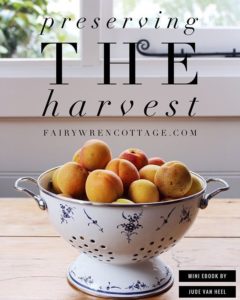
When we are making Quince Jam the kitchen reminds us of walking through our Quince Orchard just as the trees are in full blossom during Spring. Now that it is Spring I walk through our Quince Orchard wondering what we will all be doing when the quinces are ready to harvest. The summer will be behind us and we will be slowly moving into the cooler months. Such a contrast from now where it feels like we will blink and miss all the Springtime has to offer, the hum of an ever evolving, growing garden that surprises us each year.
The first time I ever tasted Quince Jam was when Michael, Liliana & I shifted back to Tasmania. Growing up in a jam making household I didn’t think it was possible that at forty there was a jam I hadn’t tasted! An old fashioned Tassie favourite so many people I know who spent their childhoods in Tassie grew up with this homemade jam on the table.

With an abundance of quinces due to having a small Quince Orchard of 27 quince trees there are always plenty to experiment with at harvest time. And I have definitely burnt enough batches to now remember year after year to never leave the stove
Over the years I have halved the sugar content in the original recipe and changed the cooking process to make it easier for me to manage.

Quinces for Jam: Look for yellow quinces, if they still have a greenish tinge to them they aren’t ready yet and have been picked too early. The quinces need to be firm, have a gentle perfume & stay away from quinces that are bruised, or have little drill like brown holes in them, those holes are caused by wasps. There are plenty more tips to help you navigate your way around the kitchen come preserving/canning time in my free easy to read ebooks. You can download them from My Ebooks page on this website.

Coring a quince is a little bit different to coring an apple. The area around the core of a quince can be quite grainy and stick in your teeth, not pleasant. Try not to include too much of that grainy area when you are chopping up the fruit. Buy a couple of extra quinces to make sure you have the equivalent of 6 quinces without too many grainy bits. Don’t let this handy tip put you off, it is just something worth sharing that I have learnt along the way.
Fairy Wren Cottage Quince Jam
Ingredients:
6 large organic quinces, peel & core
enough water to cover the quinces by 3cm
1.5kg of white sugar
Method:
Place the quinces in a large saucepan and cover with water by 3cm.
Gently stew the fruit over a low heat. The water and fruit will blend together. Stir occasionally, this can take 40 to 60minutes.
Once the fruit has broken down and become very soft turn your hotplate up so the fruit starts to bubble gently. Our hotplate ranges from 0 to 9 being the hottest, for this part of the recipe I set the hotplate on 4 or 5. You don’t want a rolling boil, it is too hot & the jam will burn quickly.
In small batches add your sugar while constantly stirring to prevent the fruit & sugar from sticking to the bottom of the saucepan.
Continue to stir until the fruit, water & sugar thickens to a jam like consistency.
I use a slotted spoon with a comfortable handle when I stir the jam and always stir it in a clock wise motion, moving from the outside to the inside of the pan making sure the spoon covers every area.
To test if the jam is ready I stir the jam with my slotted spoon then flip the spoon over when I take it out of the jam. I run a cold teaspoon across the back of the slotted spoon. If the quince jam doesn’t run back into the indent I just made with the teaspoon I know that the jam is ready. Some cooks use a cold bread & butter plate they put in the fridge and then put a dollop of jam on it and run a spoon through it. If the jam doesn’t move it means it is ready. Either option works well.
Happy Cooking,
Jude x
Quinces for Jam
October 18, 2019
comments
share